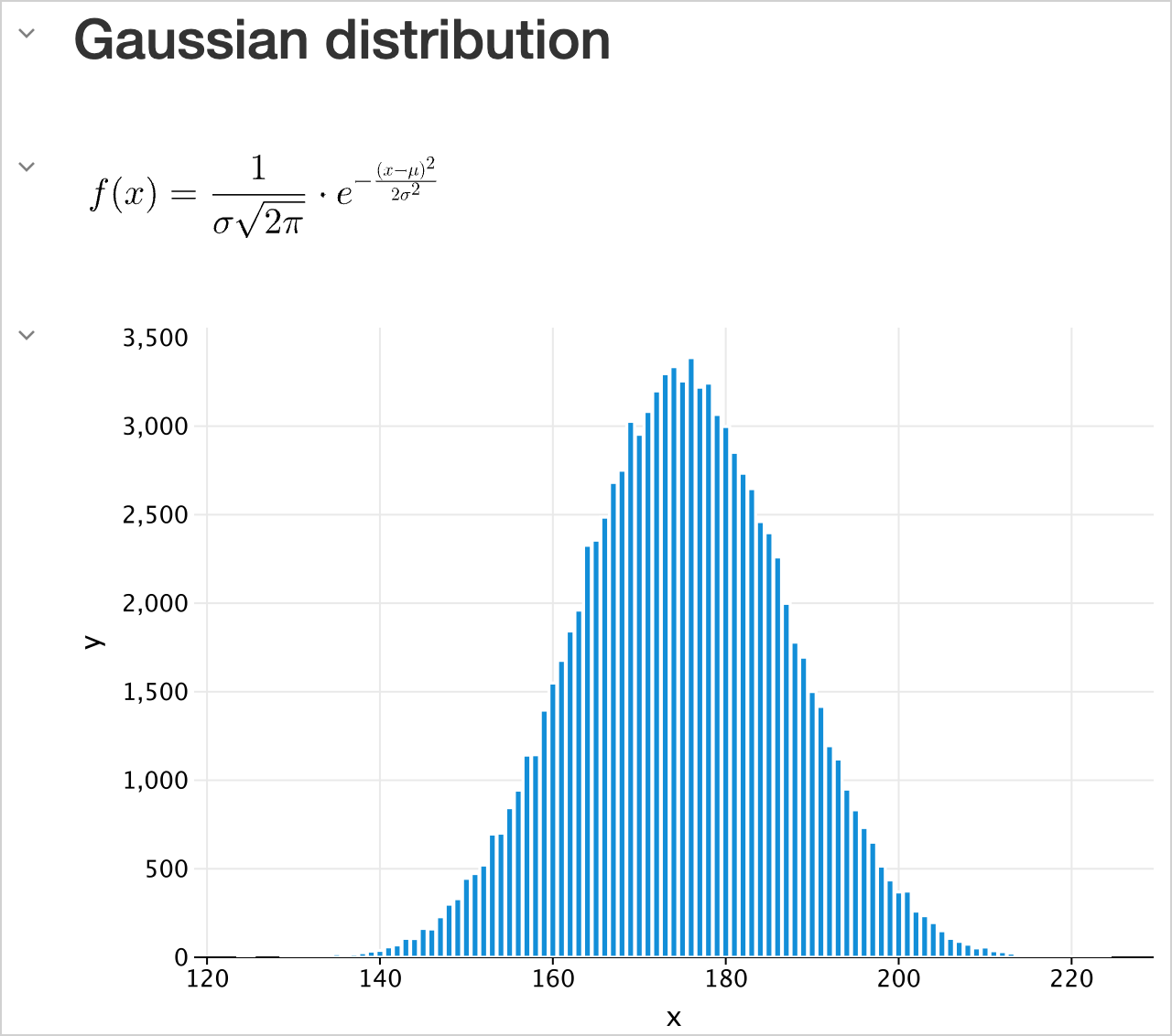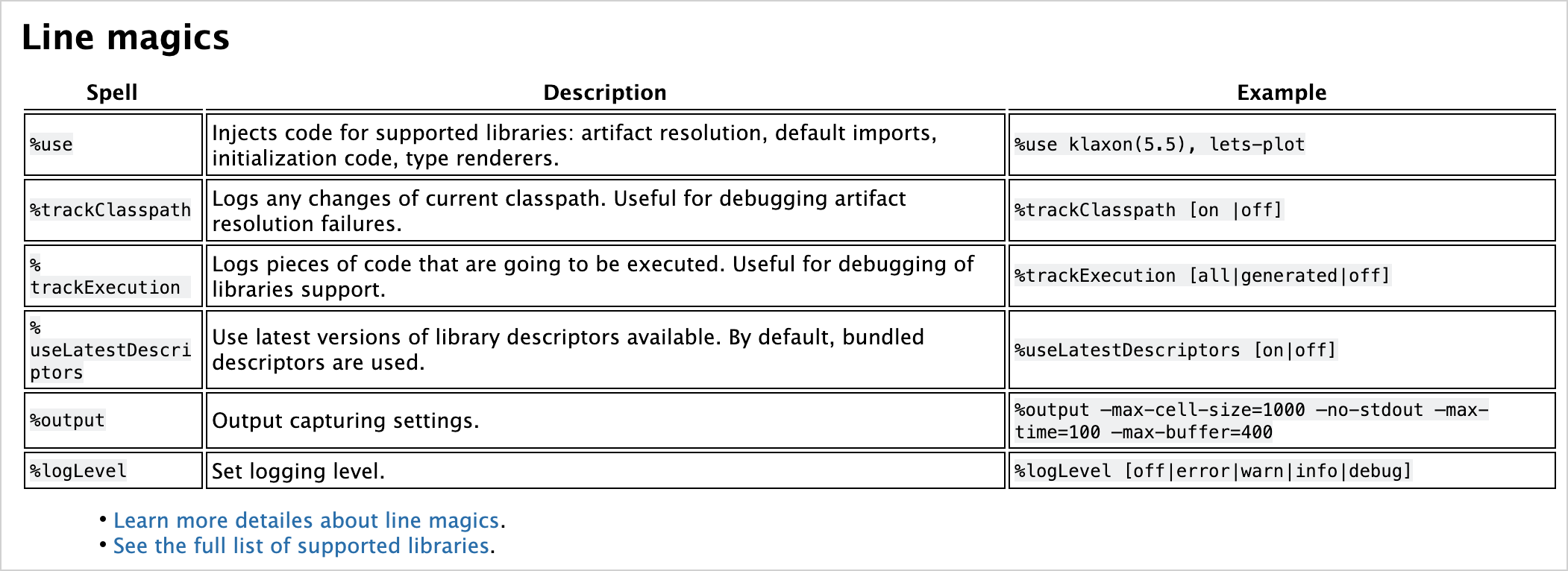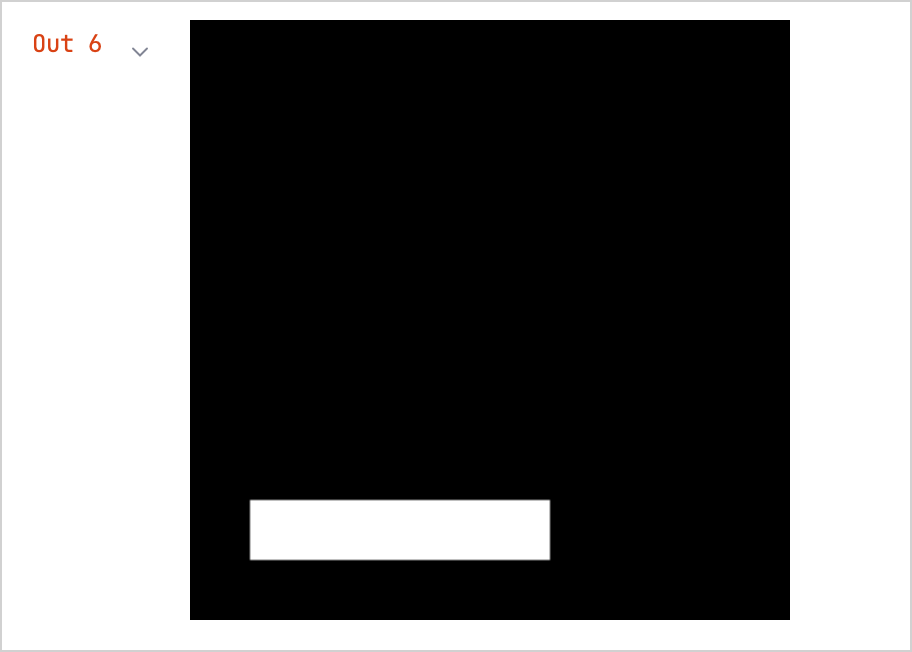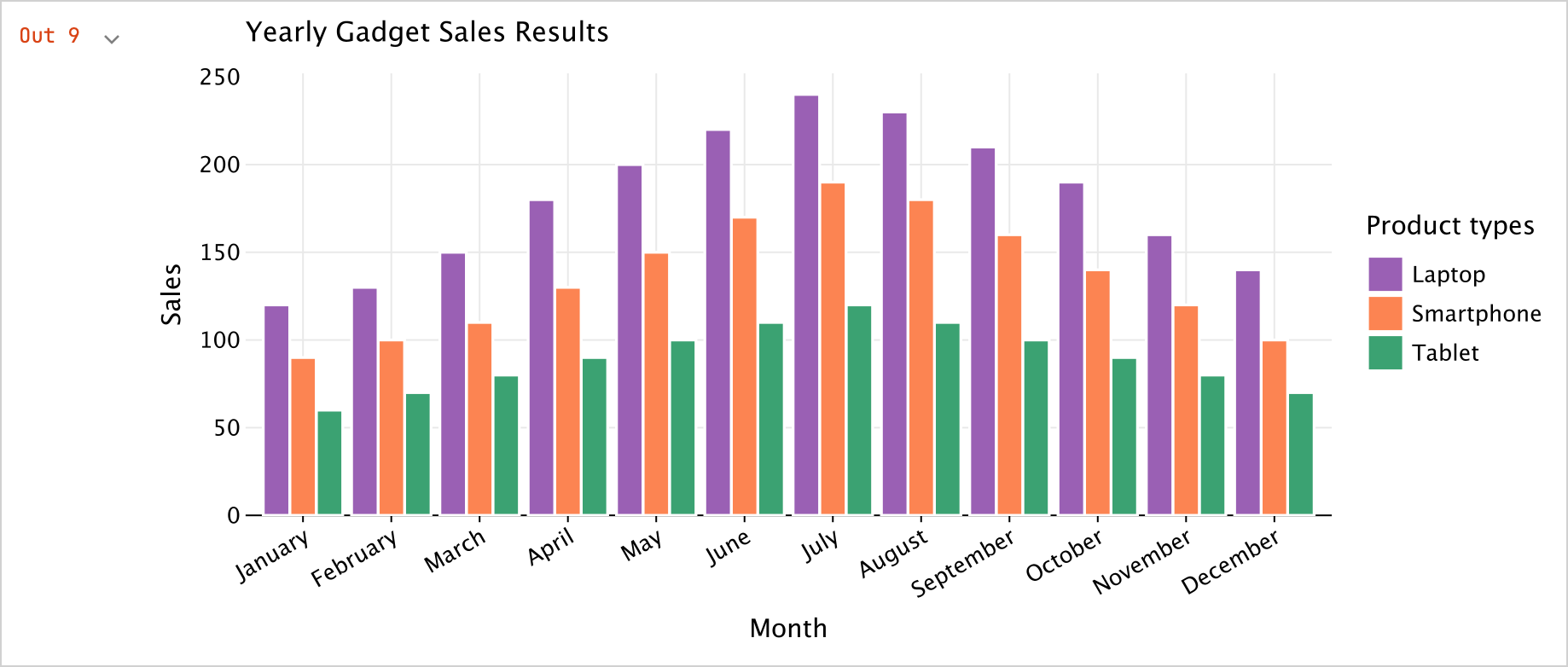Kotlin Notebook 支援的輸出格式
Kotlin Notebook 支援多種輸出類型,包含文字、HTML 和圖片。藉由外部函式庫的協助,你可以擴展你的輸出選項,並用圖表、試算表等方式視覺化你的資料。
每個輸出都是一個 JSON 物件,將 Jupiter MIME 類型 對應到某些資料。Kotlin Notebook 會從這個對應中,選取支援度最高 (priority) 的 MIME 類型,並以下列方式呈現:
- 文字 (Text) 使用
text/plainMIME 類型。 - BufferedImage 類別 使用
image/pngMIME 類型,該類型會對應到 Base64 字串。 - Image 類別,以及 LaTeX 格式,使用
text/htmlMIME 類型,並在其中包含img標籤 (tag)。 - Kotlin DataFrame 表格 和 Kandy 圖表 使用它們自己的內部 MIME 類型,這些類型由靜態 HTML 或圖片支援。這樣,你就可以在 GitHub 上顯示它們。
你可以手動設定對應,例如,使用 Markdown 作為儲存格 (cell) 輸出:
MimeTypedResult(
mapOf(
"text/plain" to "123",
"text/markdown" to "# HEADER",
//other mime:value pairs
)
)
要顯示任何種類的輸出,請使用 DISPLAY() 函式。它也支援合併多個輸出:
DISPLAY(HTML("<h2>Gaussian distribution</h2>"))
DISPLAY(LATEX("f(x) = \\frac{1}{\\sigma \\sqrt{2\\pi}} \\cdot e^{-\\frac{(x - \\mu)^2}{2\\sigma^2}}"))
val experimentX = experimentData.map { it.key }
val experimentY = experimentData.map { it.value }
DISPLAY(plot {
bars {
x(experimentX)
y(experimentY)
}
})

文字 (Texts)
純文字 (Plain text)
最簡單的輸出類型是純文字。它用於列印的陳述式 (statement)、變數值,或來自你程式碼的任何基於文字的輸出:
val a1: Int = 1
val a2: Int = 2
var a3: Int? = a1 + a2
"My answer is $a3"

- 如果儲存格 (cell) 的結果無法被 呈現 並顯示為任何輸出類型,它會使用
toString()函式以純文字形式列印。 - 如果你的程式碼包含錯誤,Kotlin Notebook 會顯示錯誤訊息和追蹤 (traceback),提供偵錯的資訊。
豐富文字 (Rich text)
選擇 Markdown 類型的儲存格 (cell) 以使用豐富文字。這樣,你可以使用 Markdown 和 HTML 標記 (markup) 格式化內容,使用清單、表格、字型樣式、程式碼區塊等。HTML 可以包含 CSS 樣式和 JavaScript。
## Line magics
| Spell | Description | Example |
|------------------------------------|------------------------------------------------------------------------------------------------------------------|---------------------------------------------------------------------------------------|
| `%use` | Injects code for supported libraries: artifact resolution, default imports, initialization code, type renderers. | `%use klaxon(5.5), lets-plot` |
| `%trackClasspath` | Logs any changes of current classpath. Useful for debugging artifact resolution failures. | `%trackClasspath [on |off]` |
| `%trackExecution` | Logs pieces of code that are going to be executed. Useful for debugging of libraries support. | `%trackExecution [all|generated|off]` |
| `%useLatestDescriptors` | Use latest versions of library descriptors available. By default, bundled descriptors are used. | `%useLatestDescriptors [on|off]` |
| `%output` | Output capturing settings. | `%output --max-cell-size=1000 --no-stdout --max-time=100 --max-buffer=400` |
| `%logLevel` | Set logging level. | `%logLevel [off|error|warn|info|debug]` |
<ul><li><a href="https://github.com/Kotlin/kotlin-jupyter/blob/master/docs/magics">Learn more detailes about line magics</a>.</li>
<li><a href="https://github.com/Kotlin/kotlin-jupyter/blob/master/docs/magics">See the full list of supported libraries</a>.</li></ul>

HTML
Kotlin Notebook 可以直接呈現 HTML,執行腳本 (script) 甚至嵌入網站:
HTML("""
<p>
Counter: <span id="ctr">0</span> <button onclick="inc()">Increment</button>
</p>
<script>
function inc() {
let counter = document.getElementById("ctr")
counter.innerHTML = parseInt(counter.innerHTML) + 1;
}
</script>
""")

將你的 notebook 在檔案頂端標記為 Trusted,才能夠執行腳本 (script)。
圖片 (Images)
使用 Kotlin Notebook,你可以顯示來自檔案、產生的圖表或任何其他視覺媒體的圖片。靜態圖片可以使用 .png、jpeg 和 .svg 等格式顯示。
緩衝圖片 (Buffered images)
預設情況下,你可以使用 BufferedImage 類別來顯示圖片:
import java.awt.Color
import java.awt.image.BufferedImage
val width = 300
val height = width
val image = BufferedImage(width, height, BufferedImage.TYPE_INT_ARGB)
val graphics = image.createGraphics()
graphics.background = Color.BLACK
graphics.clearRect(0, 0, width, height)
graphics.setRenderingHint(
java.awt.RenderingHints.KEY_ANTIALIASING,
java.awt.RenderingHints.VALUE_ANTIALIAS_ON
)
graphics.color = Color.WHITE
graphics.fillRect(width / 10, height * 8 / 10, width * 10 / 20, height / 10)
graphics.dispose()

載入的圖片 (Loaded images)
藉由 lib-ext 函式庫的協助,你可以擴展標準 Jupyter 功能,並顯示從網路載入的圖片:
%use lib-ext(0.11.0-398)
Image("https://kotlinlang.org/docs/images/kotlin-logo.png", embed = false).withWidth(300)

嵌入的圖片 (Embedded images)
從網路載入圖片的一個缺點是,如果連結中斷或失去網路連線,圖片就會消失。要解決這個問題,請使用嵌入的圖片,例如:
val kotlinMascot = Image("https://blog.jetbrains.com/wp-content/uploads/2023/04/DSGN-16174-Blog-post-banner-and-promo-materials-for-post-about-Kotlin-mascot_3.png", embed = true).withWidth(400)
kotlinMascot

數學公式和方程式 (Math formulas and equations)
你可以使用 LaTeX 格式呈現數學公式和方程式,LaTeX 格式是一種廣泛用於學術界的排版系統:
-
將擴展 Jupyter 核心 (kernel) 功能的
lib-ext函式庫新增到你的 notebook:%use lib-ext(0.11.0-398) -
在新的儲存格 (cell) 中,執行你的公式:
LATEX("c^2 = a^2 + b^2 - 2 a b \\cos\\alpha")
數據框架 (Data frames)
使用 Kotlin Notebook,你可以使用數據框架 (data frame) 可視化結構化數據:
-
將 Kotlin DataFrame 函式庫新增到你的 notebook:
%use dataframe -
建立數據框架 (data frame) 並在新的儲存格 (cell) 中執行它:
val months = listOf(
"January", "February",
"March", "April", "May",
"June", "July", "August",
"September", "October", "November",
"December"
)
// Sales data for different products and regions:
val salesLaptop = listOf(120, 130, 150, 180, 200, 220, 240, 230, 210, 190, 160, 140)
val salesSmartphone = listOf(90, 100, 110, 130, 150, 170, 190, 180, 160, 140, 120, 100)
val salesTablet = listOf(60, 70, 80, 90, 100, 110, 120, 110, 100, 90, 80, 70)
// A data frame with columns for Month, Sales, and Product
val dfSales = dataFrameOf(
"Month" to months + months + months,
"Sales" to salesLaptop + salesSmartphone + salesTablet,
"Product" to List(12) { "Laptop" } + List(12) { "Smartphone" } + List(12) { "Tablet" },
)數據框架 (data frame) 使用
dataFrameOf()函式,並包含在 12 個月期間銷售的產品數量 (筆記型電腦、智慧型手機和平板電腦)。 -
探索你的框架 (frame) 中的資料,例如,找到銷售額最高的產品和月份:
dfSales.maxBy("Sales")
-
你也可以將你的數據框架 (data frame) 匯出為 CSV 檔案:
// Export your data to CSV format
dfSales.writeCSV("sales-stats.csv")
圖表 (Charts)
你可以在 Kotlin Notebook 中直接建立各種圖表,以視覺化你的資料:
-
將 Kandy 繪圖函式庫新增到你的 notebook:
%use kandy -
使用相同的數據框架 (data frame) 並且在新的儲存格 (cell) 中執行
plot()函式:val salesPlot = dfSales.groupBy { Product }.plot {
bars {
// Access the data frame's columns used for the X and Y axes
x(Month)
y(Sales)
// Access the data frame's column used for categories and sets colors for these categories
fillColor(Product) {
scale = categorical(
"Laptop" to Color.PURPLE,
"Smartphone" to Color.ORANGE,
"Tablet" to Color.GREEN
)
legend.name = "Product types"
}
}
// Customize the chart's appearance
layout.size = 1000 to 450
layout.title = "Yearly Gadget Sales Results"
}
salesPlot
-
你也可以將你的繪圖匯出為
.png、jpeg、.html或.svg格式:// Specify the output format for the plot file:
salesPlot.save("sales-chart.svg")